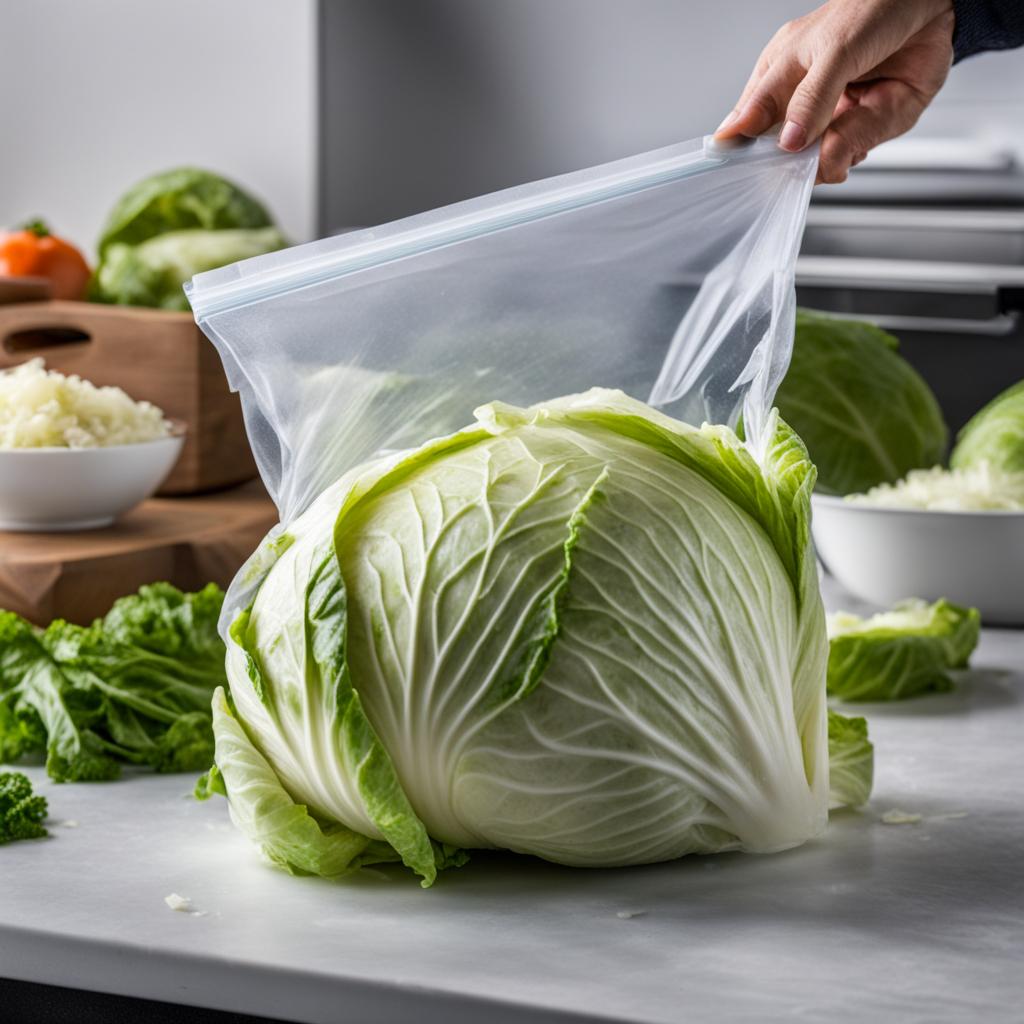In this comprehensive guide, I will walk you through the step-by-step process of freezing cabbage, including preparation, blanching, freezing, and storage. With these easy tips, you can enjoy the freshness and flavor of cabbage all year round.
Key Takeaways:
- Freezing cabbage is a simple and convenient way to preserve this versatile vegetable for long-term use.
- Proper preparation, blanching, and freezing techniques are crucial for maintaining the texture, taste, and quality of the cabbage during storage.
- Frozen cabbage can be used in various recipes, such as soups, stews, and stir-fries.
- Thawing frozen cabbage is not always necessary, depending on how you plan to use it in your recipes.
- Follow these tips and techniques to confidently freeze cabbage and enjoy its benefits in your cooking.
Benefits of Freezing Cabbage
Freezing cabbage offers numerous benefits in terms of preservation and storage. By freezing cabbage, you can extend its shelf life and maintain its nutritional value for future use. This convenient method allows you to prevent waste and have a readily available supply of cabbage whenever you need it.
When you freeze cabbage, you are essentially preserving it at its peak freshness. The freezing process helps to retain the vegetable’s texture, color, and flavor, enabling you to enjoy the same quality as if it were freshly harvested. This is especially beneficial when you want to use cabbage in soups, stews, salads, or coleslaw, as the frozen cabbage will still provide the desired taste and texture.
Additionally, freezing cabbage allows you to store it in bulk or in batches. Whether you have a surplus of cabbage from your garden or want to take advantage of a sale at the grocery store, freezing provides a great solution. With proper freezing techniques, you can preserve the versatility of cabbage and have it readily available for various recipes throughout the year.
Table: Nutritional Comparison – Fresh vs. Frozen Cabbage
| Nutrient | Fresh Cabbage (per 100g) | Frozen Cabbage (per 100g) |
|---|---|---|
| Calories | 25 | 31 |
| Carbohydrates (g) | 5.8 | 7.3 |
| Fiber (g) | 2.2 | 2.3 |
| Protein (g) | 1.3 | 1.4 |
| Fat (g) | 0.1 | 0.2 |
| Vitamin C (mg) | 36.6 | 38.5 |
The table above provides a nutritional comparison between fresh and frozen cabbage. While there may be slight variations in certain nutrients due to the freezing process, frozen cabbage still retains a significant amount of its original nutritional value. This makes it a healthy choice for incorporating into your meals, even after it has been frozen.
Choosing and Preparing Cabbage for Freezing
When it comes to freezing vegetables at home, cabbage is a versatile option that can be stored for long periods of time. To ensure the best results, it’s important to properly choose and prepare the cabbage before freezing it. Here are the steps to follow:
- Choose fresh cabbage: Select firm heads of cabbage without any damage or wilted leaves. Look for cabbage that is vibrant in color and has a tight, compact head.
- Remove outer leaves: Start by removing any tough or outer leaves from the cabbage. These leaves may not freeze well and can affect the overall quality of the frozen cabbage.
- Wash and dry: Wash the cabbage under cold running water to remove any dirt or debris. Pat it dry using a clean kitchen towel or paper towels. Ensuring that the cabbage is dry will help prevent excess moisture and freezer burn.
- Cut into desired shape: Cut the cabbage into your desired shape and size for freezing. Some options include shredding it, slicing it into wedges, or chopping it into smaller pieces. Consider how you plan to use the cabbage in future recipes when deciding on the shape.
By following these steps, you can ensure that your cabbage is properly prepared for freezing, resulting in high-quality frozen cabbage that can be used for various dishes.

Table: Freezing Leafy Vegetables
| Vegetable | Preparation | Blanching Time | Freezing Time |
|---|---|---|---|
| Cabbage | Remove outer leaves, wash, dry, cut | 2 minutes (shredded), 3 minutes (wedges) | 8-12 months |
| Kale | Remove stems, wash, dry, chop | 2 minutes | 8-12 months |
| Spinach | Remove stems, wash, dry | 2 minutes | 8-12 months |
Proper preparation is essential for ensuring the quality and flavor of the frozen cabbage.
By following these simple steps and referring to the table above, you can confidently freeze cabbage and other leafy vegetables at home. Enjoy the convenience of having ready-to-use, preserved vegetables on hand for your favorite recipes.
Blanching Cabbage for Freezing
Blanching is a crucial step in the process of freezing cabbage, as it helps to preserve the texture, color, and flavor of the vegetable. By blanching cabbage before freezing it, you can ensure that it retains its nutrients and tastes great when used in soups, stews, or salads. Here are the instructions for blanching cabbage:
Instructions:
- Bring a large pot of water to a boil.
- While the water is heating up, prepare the cabbage by removing any tough or outer leaves and washing it under cold running water.
- Cut the cabbage into your desired shape and size, such as shredding it or slicing it into wedges.
- Once the water is boiling, add the cabbage to the pot and blanch it for a specific amount of time based on the shape:
- If you have shredded cabbage, blanch it for 1.5 to 2 minutes.
- If you have cabbage wedges, blanch them for 3 to 4 minutes.
Blanching cabbage is a simple yet important step in the process of freezing it. By following these instructions, you can ensure that your frozen cabbage retains its quality and tastes delicious when used in various recipes.

| Blanching Instructions for Cabbage | Shredded Cabbage | Cabbage Wedges |
|---|---|---|
| Blanching Time | 1.5 to 2 minutes | 3 to 4 minutes |
Freezing Cabbage Properly
When it comes to freezing cabbage, proper techniques are essential to maintain its texture, taste, and quality during storage. Here are some tips and tricks to ensure you freeze cabbage effectively:
- Preserving vegetables in batches: If you have a large quantity of cabbage, consider freezing it in batches. This allows for easier organization and makes it simpler to defrost only the amount you need for a particular recipe.
- Freezing vegetables in bulk: Freezing cabbage in bulk is a convenient way to have a ready-to-use supply on hand. Prepare and blanch the cabbage, then freeze it in portion-sized bags or containers, removing as much air as possible to prevent freezer burn.
- Cabbage preserving tips: To maintain the quality of the frozen cabbage, make sure to drain and dry it thoroughly after blanching. Excess moisture can lead to freezer burn, affecting the taste and texture of the cabbage.
- Preserving vegetables at home: Freezing cabbage is a great way to preserve this versatile vegetable at home. By following the proper steps, you can enjoy the benefits of cabbage all year round.
Remember, proper freezing techniques are crucial for preserving the taste, texture, and nutritional value of cabbage. By applying these tips, you’ll be able to enjoy the freshness and convenience of frozen cabbage in your favorite recipes.
Table: Proper Freezing Techniques
| Technique | Description |
|---|---|
| Bulk freezing | Freeze a large quantity of cabbage at once for long-term storage. |
| Batching | Freeze smaller portions of cabbage for easier organization and defrosting. |
| Draining and drying | Thoroughly remove excess moisture from the cabbage to prevent freezer burn. |
| Proper packaging | Use airtight bags or containers, removing as much air as possible. |
| Labeling | Date the frozen cabbage for easy identification and rotation. |
In summary, freezing cabbage properly involves considering the quantity, packaging, and preservation techniques. By following these tips and tricks, you can enjoy the convenience and freshness of frozen cabbage for months to come.
Storing Frozen Cabbage
Proper storage is crucial for maintaining the quality of frozen cabbage. To ensure that your frozen cabbage remains fresh and flavorful, follow these cabbage freezing preparations and techniques:
- Use freezer-safe bags or containers: When storing frozen cabbage, it’s essential to use airtight freezer-safe bags or containers that are sealed tightly. This prevents air and moisture from entering, which can lead to freezer burn and deterioration of the cabbage’s quality.
- Label the bags: To easily identify and rotate the stored cabbage, label the bags with the date of freezing. This will help you keep track of the cabbage’s storage time and ensure that you use it within the recommended timeframe.
- Store at the right temperature: Frozen cabbage should be stored in the freezer at a temperature of 0°F (-18°C) or below. This ensures that the cabbage remains properly frozen and maintains its quality over time.
- Use within recommended timeframe: While frozen cabbage can be stored for up to 6 months without significant loss of quality, it’s best to use it within 3-4 months for optimal taste and texture.
By following these cabbage preserving preparations and techniques, you can ensure that your frozen cabbage stays fresh, flavorful, and ready to use whenever you need it.
Table: Proper Storage Guidelines for Frozen Cabbage
| Step | Description |
|---|---|
| Use freezer-safe bags or containers | Seal the cabbage in airtight freezer-safe bags or containers to prevent air and moisture from entering, which can cause freezer burn. |
| Label the bags | Label the bags with the date of freezing for easy identification and rotation of the stored cabbage. |
| Store at the right temperature | Store the frozen cabbage in the freezer at a temperature of 0°F (-18°C) or below to maintain its quality. |
| Use within recommended timeframe | For the best taste and texture, use the frozen cabbage within 3-4 months. |
By following these guidelines, you can ensure that your frozen cabbage stays delicious and ready to enhance your favorite recipes.
Thawing Frozen Cabbage
When it comes to using frozen cabbage in your recipes, the thawing process will depend on how you plan to incorporate it. If you’re adding the cabbage directly to cooked dishes like soups or stir-fries, you can use it straight from the freezer without thawing. This convenience allows you to save time and effortlessly enhance the flavors of your favorite dishes.
However, if you’re planning to use the cabbage in raw preparations such as coleslaw or salads, it’s best to thaw it in the refrigerator overnight. This gradual thawing process helps the cabbage retain its texture and crispness, ensuring optimal results in your raw recipes. Remember to place the frozen cabbage in a sealed container or bag to prevent any cross-contamination or moisture loss in your fridge.
Thawing times may vary depending on the size and thickness of the cabbage pieces. For larger chunks or whole leaves, you may need to allow for additional thawing time. A good rule of thumb is to check the cabbage periodically and ensure it is fully thawed before using it in your recipes. By following these simple tips, you can easily incorporate frozen cabbage into your cooking while maintaining its taste and quality.
Using Frozen Cabbage in Recipes
Once you have successfully frozen your cabbage and stored it properly, you can start incorporating it into various recipes for a convenient and nutritious addition to your meals. Here are some ideas on how to use frozen cabbage:
1. Soups and Stews
Frozen cabbage is perfect for adding to hearty soups and stews. Whether you’re making a classic vegetable soup or a comforting cabbage and sausage stew, the frozen cabbage will cook down and blend seamlessly with other ingredients, adding texture and flavor to your dish. Just toss the frozen cabbage directly into the pot and let it simmer until it’s heated through.
2. Stir-Fries
Frozen cabbage can also be a great addition to stir-fries. It adds a refreshing crunch and a hint of sweetness to your stir-fry dishes. Simply toss the frozen cabbage into the skillet or wok with your other vegetables and protein, and cook until it’s thawed and heated. The cabbage will retain its texture and taste, giving your stir-fry a delicious twist.
3. Casseroles and Bakes
When making casseroles or bakes, you can use frozen cabbage as a nutritious vegetable layer. Whether you’re making a cabbage casserole, a cheesy cabbage gratin, or a stuffed cabbage bake, the frozen cabbage will cook perfectly in the oven. Just thaw it slightly before assembling your dish, and bake until it’s tender and golden brown.
| Recipe | Ingredients | Instructions |
|---|---|---|
| Cabbage and Sausage Stew | – Frozen cabbage – Sausage – Onion – Garlic – Potatoes – Chicken broth – Herbs and spices – Salt and pepper to taste |
1. In a large pot, cook the sausage until browned. Remove from the pot and set aside. 2. In the same pot, sauté the onion and garlic until fragrant. 3. Add the potatoes, chicken broth, herbs, and spices. Bring to a boil. 4. Reduce heat to a simmer and add the frozen cabbage and cooked sausage. 5. Cover the pot and let it simmer for about 20-30 minutes, or until the cabbage is tender. 6. Season with salt and pepper to taste. 7. Serve hot and enjoy! |
| Cabbage Stir-Fry | – Frozen cabbage – Mixed vegetables – Tofu or chicken (optional) – Soy sauce – Garlic – Ginger – Sesame oil – Salt and pepper to taste |
1. Heat a skillet or wok over medium-high heat. 2. Add the garlic and ginger and sauté until fragrant. 3. Add the tofu or chicken (if using) and cook until browned. 4. Add the mixed vegetables and frozen cabbage. Stir-fry until heated through. 5. Drizzle with soy sauce and sesame oil. 6. Season with salt and pepper to taste. 7. Serve hot with steamed rice or noodles. |
| Cabbage Casserole | – Frozen cabbage – Ground beef or turkey – Onion – Garlic – Rice – Tomato sauce – Cheese – Herbs and spices – Salt and pepper to taste |
1. Preheat the oven to 375°F (190°C). 2. In a skillet, cook the ground beef or turkey until browned. Remove from the skillet and set aside. 3. In the same skillet, sauté the onion and garlic until softened. 4. Add the rice, tomato sauce, herbs, and spices. Cook until the rice is partially cooked. 5. In a baking dish, layer the frozen cabbage, cooked meat, and rice mixture. 6. Sprinkle with cheese. 7. Cover the dish with foil and bake for 30 minutes. 8. Remove the foil and bake for an additional 15 minutes, or until the cheese is golden and bubbly. 9. Let it cool for a few minutes before serving. |
As you can see, frozen cabbage can be used in a variety of recipes to add nutrition and convenience to your daily meals. Take advantage of your frozen cabbage stash and experiment with different flavors and cuisines. So, don’t hesitate to freeze your cabbage for later use, as it offers a long-term solution to preserving this versatile vegetable.
Tips for Freezing Cabbage
When it comes to freezing cabbage, there are a few key methods and techniques to keep in mind to ensure the best results. Here are some helpful tips:
- Use airtight freezer bags or containers: To prevent freezer burn and maintain the quality of the cabbage, it’s important to use freezer-safe bags or containers that can be tightly sealed. This will help keep out air and moisture, which can affect the texture and flavor of the frozen cabbage.
- Remove excess air: When packaging the cabbage for freezing, try to remove as much air as possible from the bags or containers. This can be done by gently pressing out the air before sealing. Removing excess air will help preserve the quality of the cabbage during storage.
- Label the bags: To easily identify the frozen cabbage and keep track of its storage time, it’s a good idea to label the bags with the date of freezing. This will ensure that you use the oldest cabbage first and help prevent any potential waste.
- Blanch the cabbage: Blanching the cabbage before freezing can help preserve its color and flavor. To blanch cabbage, briefly boil it in water and then immediately transfer it to an ice water bath to cool. This process helps to stop the enzymes that can cause the cabbage to deteriorate in texture and taste.
- Dry the cabbage: Before freezing, make sure to dry the cabbage thoroughly to remove any excess moisture. Excess moisture can lead to freezer burn and affect the quality of the frozen cabbage. Pat dry the cabbage with a clean kitchen towel or paper towels before packaging it for freezing.
By following these vegetable freezing methods and vegetable preserving methods, you can ensure that your frozen cabbage retains its freshness, flavor, and nutritional value for months to come. Whether you’re stocking up on cabbage during harvest season or looking to use up a surplus, freezing cabbage is a convenient way to enjoy this versatile vegetable all year round.
Remember, properly frozen cabbage can be a great addition to various dishes like soups, stews, and stir-fries. So don’t hesitate to freeze and store cabbage for later use. With these tips, you’ll be able to preserve the quality of your cabbage and enjoy its taste and texture whenever you need it.
Conclusion
Freezing vegetables without losing nutrients is a great way to ensure you always have a supply of fresh produce on hand. Cabbage, in particular, can be easily preserved through the simple process of blanching and freezing. By following the steps outlined in this guide, you can maintain the taste, texture, and nutritional value of cabbage for long-term use.
With frozen cabbage, you can easily incorporate this versatile vegetable into various recipes, such as soups, stews, and stir-fries. While the texture may soften slightly during freezing, the flavor remains intact, allowing you to enjoy the benefits of cabbage throughout the year.
Remember to properly label and store your frozen cabbage in airtight containers or freezer bags to prevent freezer burn. By following these tips and techniques, you can confidently freeze cabbage and enjoy its freshness whenever you need it. So go ahead and start preserving your cabbage today!
FAQ
How do I freeze cabbage?
Freezing cabbage is a simple process. Start by preparing the cabbage by removing any tough or outer leaves, washing it under cold water, and cutting it into your desired shape and size. Next, blanch the cabbage in boiling water for a specific amount of time based on the shape. After blanching, drain and dry the cabbage thoroughly before freezing. Freeze the cabbage in a single layer on a baking sheet lined with parchment paper, then transfer it to freezer-safe bags or containers. Label the bags with the date of freezing and store the cabbage in the freezer at 0°F or below.
Why should I freeze cabbage?
Freezing cabbage offers various benefits, including extending its shelf life and preserving its nutritional value. By properly freezing cabbage, you can prevent waste and have a ready-to-use supply of this versatile vegetable on hand whenever you need it. Whether you want to use cabbage in soups, stews, salads, or coleslaw, freezing allows you to conveniently store and preserve this nutritious vegetable.
Can I freeze cabbage without blanching?
Blanching is an important step in the freezing process to preserve the texture, color, and flavor of cabbage. While you can technically freeze cabbage without blanching, it may result in a lower quality and less flavorful end product. Blanching helps to retain the cabbage’s nutrients and ensures better results when using it in various recipes.
How long can I store frozen cabbage?
Frozen cabbage can be stored for up to 6 months without significant loss of quality. However, for best results, it’s advisable to use it within 3-4 months. Proper storage at 0°F or below in airtight freezer bags or containers is crucial for maintaining the texture, taste, and quality of the cabbage during storage.
Do I need to thaw frozen cabbage before using it?
Whether you need to thaw frozen cabbage depends on how you intend to use it. If you plan to add the cabbage directly to cooked dishes like soups or stir-fries, you can use it straight from the freezer without thawing. However, if you want to use the cabbage in raw preparations like coleslaw, it’s best to thaw it in the refrigerator overnight to preserve its texture.
Can I use frozen cabbage in coleslaw?
While frozen cabbage can be used in cooked dishes like soups, stews, and stir-fries, it is not recommended for use in coleslaw. The texture of thawed cabbage may undergo changes that make it less ideal for raw preparations like coleslaw. It’s best to use fresh cabbage for coleslaw recipes.
What are some tips for freezing cabbage?
Here are some additional tips for freezing cabbage:
– Use airtight freezer bags or containers to prevent freezer burn.
– Remove as much air as possible from the bags to maintain the quality of the cabbage.
– Label the bags with the date of freezing for easy identification.
– Blanch the cabbage before freezing to preserve its color and flavor.
– Dry the cabbage thoroughly before freezing to prevent excess moisture.
Source Links
- https://itsavegworldafterall.com/how-to-freeze-cabbage/
- https://www.eatingwell.com/article/7908899/can-you-freeze-cabbage/
- https://www.cleaneatingkitchen.com/how-to-freeze-cabbage/
Related Recipes:
 How to Cut Cabbage for Different Recipes
How to Cut Cabbage for Different Recipes
 How to Freeze Corn: Tips for Freshness
How to Freeze Corn: Tips for Freshness
 How to Freeze Green Beans for Best Quality
How to Freeze Green Beans for Best Quality
 How to Freeze Carrots: A Step-by-Step Guide
How to Freeze Carrots: A Step-by-Step Guide
 How to Freeze Bananas? (Perfect Step-By-Step Guide)
How to Freeze Bananas? (Perfect Step-By-Step Guide)
 How to Blanch Tomatoes? (Perfect Step-By-Step Guide)
How to Blanch Tomatoes? (Perfect Step-By-Step Guide)
 How to Freeze Spinach? (Perfect Step-By-Step Guide)
How to Freeze Spinach? (Perfect Step-By-Step Guide)
 How to Freeze Blackberries: A Guide
How to Freeze Blackberries: A Guide








